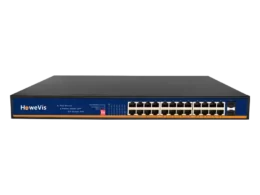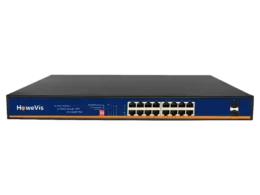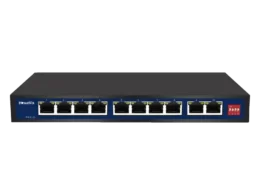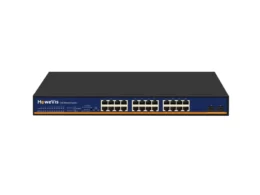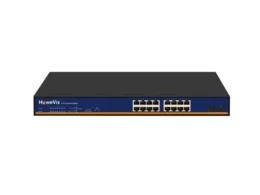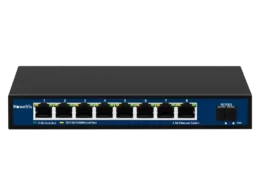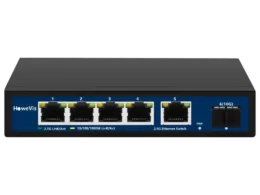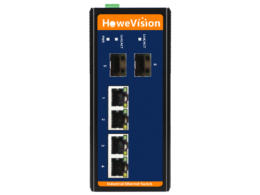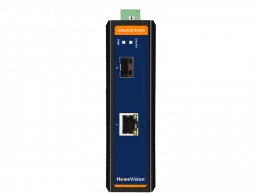How many 2 million IP cameras connect to a gigabit switch, and how many can connect to 24 cameras with a 24-port 100-megabit switch? Here are some simple analyses of such issues!
According to the camera stream and the number to choose
The camera code stream
Before choosing a switch, the first thing to figure out how much bandwidth each image takes up.
The number of cameras
To find out the bandwidth capacity of the switch. Commonly used switches are 100-megabit switches and gigabit switches. The actual bandwidth is generally only 60 to 70% of the theoretical value. So the available bandwidth of ports is roughly 60Mbps or 600Mbps.
Example.
Depending on the brand of the network camera, you use to see the single code stream and then estimate how many cameras can connect to a switch.
For example, 1.3 million: 960p camera single bitstream usually 4M, with a 100 megabit switch, then you can connect 15 units (15 × 4 = 60M).
With a gigabit switch, you can receive 150 (150 × 4 = 600M)
2 million: 1080P camera single bitstream usually 8M, with a 100 megabit switch, then you can connect 7 (7 × 8 = 56M)
With a gigabit switch, you can connect 75 units (75 × 8 = 600M)
These are the mainstream H.264 cameras; as an example to explain to you, H.265 cut in half will be able to.
In terms of network topology, the LAN is usually a two-layer to a three-layer structure. The camera side is at the access layer; usually, a 100-megabit switch is enough unless you connect many cameras on one switch.
The aggregation layer and core layer are calculated by how many images are aggregated by that switch.
The calculation method is as follows:
I suppose you connect the 960P network cameras, generally within 15 images, with a 100-megabit switch. More than 15 roads with a gigabit switch; if you receive 1080P network cameras, generally within eight images, with 100 megabit switch, more than eight roads with a gigabit switch.
The switch selection requirements.
The monitoring network has three layers of architecture: the core layer, the convergence layer, and the access layer.
The choice of access layer switches
Condition 1: camera stream: 4Mbps, 20 cameras is 20 * 4 = 80Mbps.
That is, the access layer switch uplink must meet the 80Mbps / s transmission rate requirements. Considering the actual switch transmission rate (usually 50% of the nominal value, 100M is only about 50 M), the access layer switch should connect with a 1000 Mbps upload port switch.
Condition 2: Backplane bandwidth of the switch, such as the choice of a 24-port switch, comes with two 1000M ports, a total of 26 ports, the access layer switches backplane bandwidth requirements: (24*100M*2 + 1000*2*2)/1000 = 8.8Gbps backplane bandwidth.
Condition 3: Packet forwarding rate: the packet forwarding rate of a 1000M port is 1.488Mpps/s, then the switch switching rate of the access layer is: (24*100M/1000M+2)*1.488=6.55Mpps.
Based on the above conditions: when there is 20 channel 720P camera access to a switch, the switch must have at least 1 1000M uplink port, more than 20 100M access ports to meet demand.
The choice of convergence layer switches
If there are five switches to access, each switch has 20 cameras. The stream is 4M, then the convergence layer traffic: 4Mbps * 20 * 5 = 400Mbps, and the convergence layer upload port must be 1000M or more.
If 5 IPCs connect to a switch, an 8-port switch is usually required, so does this 8-port switch meet the requirements? You can look at the following three aspects.
- Backplane bandwidth: Number of ports * port speed * 2 = backplane bandwidth, i.e. 8 * 100 * 2 = 1.6 Gbps.
- Packet Switching Rate: Number of ports * port speed/1000*1.488Mpps = packet switching rate, i.e., 8*100/1000*1.488=1.20Mpps. Some switches sometimes calculate that the packet switching rate cannot meet this requirement, then it is a non-linear speed switch, which is prone to cause latency when performing high-volume data throughput.
- Cascade port bandwidth: IPC code stream * number = minimum bandwidth of upload port, i.e. 4.*5 = 20Mbps. usually, when IPC bandwidth exceeds 45Mbps, it is recommended to use a 1000Mbps cascade port.
How to choose a switch?
Example
There is a campus network, more than 500 high-definition cameras, code stream of 3 ~ 4 megabytes. The network structure is divided into the access layer – convergence layer – core layer. Storage in the convergence layer, each convergence layer corresponds to 170 cameras.
The problem: how to choose the product? The difference between 100 megabits and gigabits? What are the reasons that affect the transmission of images in the network? What factors are relevant to the switch?
The sum of all port capacities x 2 times the number of ports should be less than the nominal backplane bandwidth for full-duplex, non-blocking wire-speed switching, proving that the switch has what it takes to deliver maximum data exchange performance.
Solution: a switch that can provide up to 48 Gigabit ports should have a total configuration capacity of 48 × 1G × 2 = 96Gbps to ensure non-blocking wire-speed packet switching when all ports are in full-duplex.
Packet forwarding rate
Total configuration packet forwarding rate (Mbps) = complete configuration of GE ports × 1.488Mpps + full configuration of 100 Gigabit ports × 0.1488Mpps, where the theoretical throughput of a Gigabit port at a packet length of 64 bytes is 1.488Mpps.
For example, suppose a switch can provide up to 24 Gigabit ports with a claimed packet forwarding rate of fewer than 35.71 Mbps (24 x 1.488Mpps = 35.71). In that case, it is reasonable to assume that the switch is designed with a blocking architecture.
A switch is generally the right switch when both backplane bandwidth and packet forwarding rate are met.
The backplane’s relatively large, relatively small throughput of the switch and retaining the ability to upgrade and expand makes the software efficiency / unique chip circuit design problematic; the backplane is relatively tiny. Relatively large throughput of the switch overall performance is relatively high.
Camera code stream affects the clarity, usually, the video transmission of the code stream setting (including the coding sending and receiving device codec capabilities, etc.), which is the performance of the front-end camera, and the network has nothing to do.
Usually, users think that the clarity is not high and that the network causes the idea.
According to the above case, the calculation.
Code stream: 4Mbps
Access: 24*4=96Mbps<1000Mbps<4435.2Mbps
Convergence: 170*4=680Mbps<1000Mbps<4435.2Mbps
Access switch
The primary consideration is the link bandwidth between access and convergence, i.e., the uplink capacity of the switch needs to be larger than the number of cameras accommodated at the same time * code rate.
So video recording in real-time is no problem. Still, suppose there are users in real-time to see the video. In that case, you also need to take into account this bandwidth, each user to view a video occupies the bandwidth is 4M, if an access switch for each camcorder has a person watching, you need the number of camcorders * bit rate * (1 + N) bandwidth, that is, 24 * 4 * (1 + 1) = 128M.
Convergence switch
The convergence layer needs to simultaneously handle 170 cameras 3-4M code streams (170 * 4M = 680M), which means that the convergence layer switches need to support the simultaneous forwarding of more than 680M switching capacity. General storage connects to the convergence, so the video footage is forwarded at line speed.
But to consider the bandwidth of real-time view monitoring, each connection occupies 4M. A 1000M link can support 250 cameras that are debugged calls. Each access switch connected to 24 cameras, 250/24, equivalent to the network, can withstand the pressure of each camera at the same time there are ten users in real-time view.
Core switch
The core switch requires considering the switching capacity and the link bandwidth to the convergence because the storage is placed in the convergence layer. So the core switches to no video recording pressure, that is, as long as you consider how many people are watching and how many ways to video simultaneously.
Assume that in this case, ten people are monitoring, each watching the 16-way video. That is, the switching capacity needs to be greater than 10 * 16 * 4 = 640M.
Switch selection focus
When choosing a switch for video surveillance in LAN, it is usually enough to consider the switching capacity of the access and aggregation layer switches because users are generally connected through the core switch and get video.
In addition, the primary pressure is in the convergence layer switch because both bear the traffic of monitoring storage and the pressure of real-time view call monitoring. Hence, the choice of the applicable convergence switch is significant.


